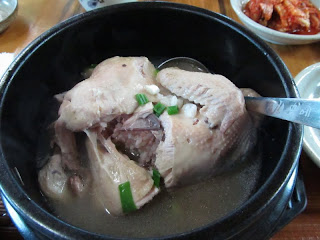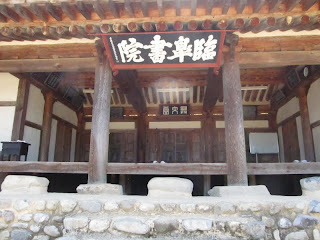Our first stop was 용담정 Yongdamjeong meaning Dragon Pool Pavillion in 경주 Kyeongju. This place is special because it is a sacred place to Cheondoism. It is dedicated to 최제우 Choi Je Woo. He formed the religion 동학 Donghak meaning "Eastern Learning". What's interesting about 동학 Donghak is that it was a foil to Catholicism but it picked up some traits of Catholicism, the religion that he was trying to counter. 동학 Donghak is a mixture of Confucianism, Buddhism, shamanism, Taosim, and magic.
The government who was orthodox Confucian saw 동학 Donghak threatening social stability and that it was political. The government saw 동학 Donghak very similar to Catholicism because they met in buildings similar to chapels for church service once a week. The government was already known for persecuting the Catholics and so they saw this religion no different than Catholicism. What was even more interesting he was executed for being a Catholic. He wasn't even Catholic!
최제우 Choi Je Woo
용담정 Dragon Pool Pavillion
병풍 Byeongpung (byungpoong) is a screen for special occasions or for use as a decorative piece in a room. They use them to celebrate birthdays, especially 돌 dol (child's first birthday), 환갑/회갑 hwan gap/hwe gap (one's sixtieth birthday), and marriage ceremonies. It's used to cover or hide space when unfolded. They date back to the 신라 Silla dynasty (aka long time ago!). They were originally used against the cold wind coming in throught the chinks in a door or a window and then gradually their use was for decoration.
After 용담정 Dragon Pool Pavillion, we had 삼계탕 Chicken soup with ginseng (samgyetang) for lunch. What's really interesting is that they say that this is the best to eat during summer because it's hot. Say what?? At first, I thought, "Why on earth would you eat hot soup in the summer?" They say it's healthy to eat during the summer; it flushes out bad things. I still prefer to eat it in the winter. I think it's ok but not "oh my gosh this stuff is amazing!" But if I was sick, I would eat this. :-)
The next place we went to was 임고서원 Imgo Seowon. 서원 Seowon (sowon) are private academies. They were established to enshrine a noteworthy scholar. 서원 Seowons had two main buildings: a lecture hall in the center of the courtyard and a shrine toward the rear or innermost part of the complex. In front of the lecture hall, to each side of the main courtyard were dormitories. The shrine building contained the "spirit tablet," a wooden plaque about a foot tall with the name of the person honored as a sage inscribed thereon.
The scholar recognized here is 정몽주 Jeong Mong Ju (Jung Mong Joo). He was a Neo-Confucian scholar. 정몽주 Jeong Mong Ju is pretty significant in Korea. Everyone in Korea knows him. He's an example of loyalty to Koreans. It was the last days of the Koryo dynasty and Korea was transitioning into the Joseon dynasty. 정몽주 Jeong Mong Ju didn't think there was a need for a new dynasty. He supported the current king and refused to support 이성계 Yi Songgye who becomes 태조왕 King Taejo, the first king of the 조선 Joseon dynasty. Yi Seonggye's son 이방원 Bangwon who later becomes 태종왕 King Taejong, the third king of the 조선 dynasty, asked 정몽주 Jeong Mong Ju to join who refused. 이방원 Bangwon kills him at a stong bridge in 개송 Kaesong (which is in North Korea currently) called the "Good Bamboo Bridge". Many people believe that 정몽주 Jeong Mong Ju's blood can still be seen here and when it rains it's bright red. But most are starting to believe that it's just iron and rust.
시조 Sijo is a form of Korean poetry. It's been said that it's replacing the simple Japanese haiku. 정몽주 Jeong Mong Ju's 시조 sijo is famous. Every Korean knows his poem. Literally. Everyone that we have asked here in Korea could recite it. This poem was recited by 정몽주 Jeong Mong Ju to 이방원 Bangwon right before 이방원 Bangwon killed him. The poem is called "One Red Heart" or sometimes "Song of Loyalty".
이몸이 죽고죽어 일백번 고처죽어
백골이 진토되어 넋이라도 있고없고
임 향한 일편단심이야 가실줄이 있으랴
-정몽주
Though I die, and die again, though I die a hundred times,
Long after my bones have turned to dust; whether my soul exists or not,
How can the loyalty, to my Lord, of this one red heart, ever fade away?
-Jeong Mong Ju. Translation by Mark Peterson.
He's pretty much saying that I'm a dead man; you can never remove my loyalty to my king. All of us have memorized this poem for the past couple of days. It's pretty cool when we asked some Koreans to recite it for us. When we would say it with them, their eyes almost fell off haha. They thought it was so cool that we knew the poem. I have to mention that the translation done by none other than our study abroad director has been used by various people on the internet. How cool is that?
Because we knew the history and significance of 정몽주 Jeong Mong Ju, it was really cool to see the 서원 seowon. When we got to the 서원 seowon they had his poem engraved in stone next to a poem his mother wrote about him. I don't have her poem memorized but when we found out the meaning of the poem, it made everything ironic. Her poem talked about that he shouldn't get involved in politics because he's too good and people will take advantage of him. Knowing the meaning of her poem and seeing his poem next to hers just made everything ironic.
임고서원 Imgo Seoweon
정몽주 Jeong Mong Ju's poem engraved in stone.
정몽주 Jeong Mong Ju
Books of 정몽주 Jeong Mong Ju
Shrine where 정몽주 Jeong Mong Ju's spirit tablets are located. There's no entry to view them. This was the closest we could get to it (zooming in on a camera).
We went to 옥산서원 Oksan seowon, another 서원 seowon. It's located in 경주 Gyeongju as well. It was built in memory of 언적 Eonjeok (uhn-juck) also known as 회재 Hoejae (hwe-jae) and to educate the young in 1572.
We spotted some poisonous frogs nearby.
We went to 양동 Yangdong again since it wasn't raining today! The villages are beautiful, rain or shine. It's just more convenient to walk and drive when it's not raining here. Pictures do not do this place justice. This place is so beautiful to look at and walk around. We saw a 서원 seowon which is the picture below and view the villages.
Seeing old Korea and seeing how much they have preserved from centuries ago is so cool to look at. I mean to keep whole villages in tact is incredible. It's neat to me that they want to preserve everything they can from their history. Just going out and walking around Korea, what you seen and have read come to life; literally, everything you have read.

































